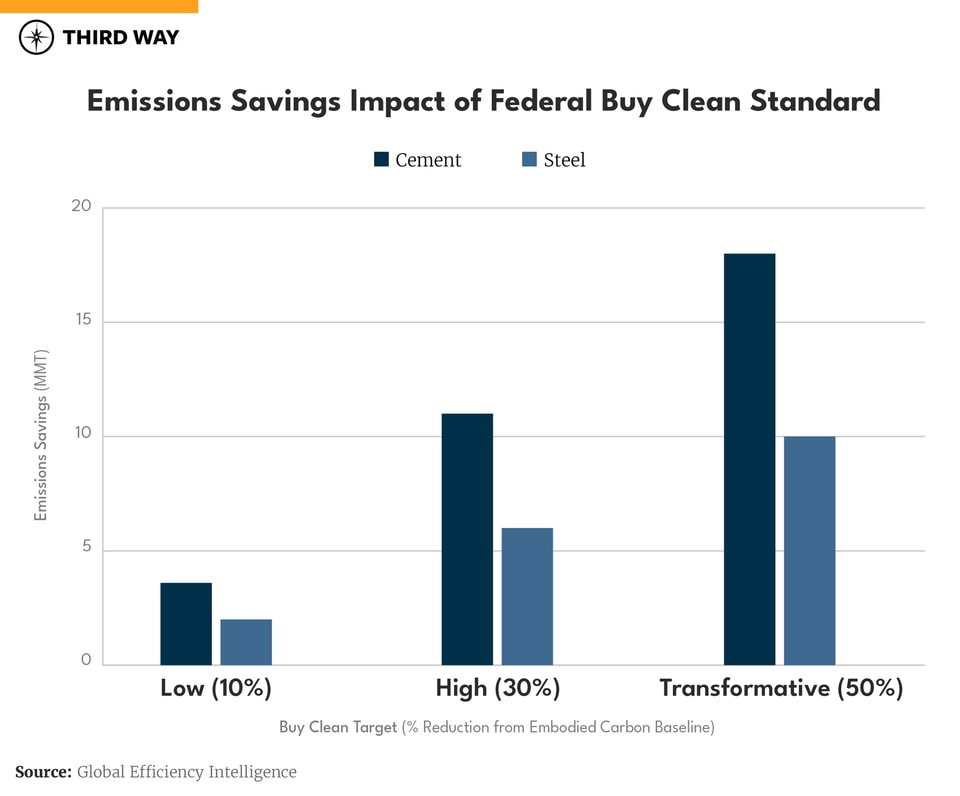Memo Published March 31, 2022 · 9 minute read
Buy Clean Offers Real Benefits for US Manufacturers and Climate Efforts
John Milko

Making the most of historic federal investments
The federal government should leverage its substantial buying power to advance national goals like reducing greenhouse gas emissions and supporting domestic manufacturing industries.
Every year the government spends billions of dollars on common construction materials to build roads, bridges, buildings, and more. In 2018, it spent an estimated $5.2 billion on concrete alone. With the recent passage of the bipartisan Infrastructure Investment and Jobs Act that will spend $1.2 trillion to upgrade and modernize our country’s aging infrastructure and potential passage of a reconciliation bill with additional infrastructure investments, Uncle Sam will be buying even more of these materials.
Already the single largest purchaser of common construction materials like concrete and steel, the federal government is uniquely positioned to shift how these products are manufactured and used in order to help decarbonize a major sector of the economy that has been historically difficult to address.
The Biden-Harris Administration clearly gets this. In February 2022, the White House announced the creation of the first-ever Buy Clean Task Force to provide guidance on procurement practices that promote the use of sustainably-manufactured construction materials for federal projects. These Buy Clean practices will effectively steer federal procurement dollars to manufacturers of materials like concrete and steel that adopt cleaner manufacturing processes. We've seen states and private sector businesses pursue Buy Clean policies to reduce their carbon footprint, and we know the federal government could make a big impact on emissions if it followed suit. But until now, we didn't know just how big.
Third Way partnered with Ali Hasanbeigi at Global Efficiency Intelligence (GEI) to quantify the potential emissions reductions at the federal level. GEI’s report, “Federal Buy Clean for Cement and Steel, Policy Design and Impact on Industrial Emissions and Competitiveness” found that a nationwide Buy Clean standard can cut millions of metric tons of carbon right away, and lead to even greater reductions as companies adopt cleaner practices to remain competitive. It also found that US industries stand to benefit from this kind of clean procurement standard.
How a Buy Clean standard works
In July 2021, the Biden-Harris Administration issued a Buy American Rule to strengthen previous regulations and ensure that products bought by the government with American tax dollars are primarily made in the U.S. This rule, and variations of Buy American rules dating back to the 1930’s, uses the power of federal procurement to support domestic manufacturers.
A federal Buy Clean rule would operate in harmony with Buy American provisions and similarly support U.S. companies while reducing industrial emissions. Under such a rule, the government must spend federal procurement dollars on common construction materials that are produced using clean manufacturing methods, as measured by a product’s embodied carbon. Embodied carbon is the sum of all the greenhouse gas emissions (mostly carbon dioxide) resulting from the mining, harvesting, processing, manufacturing, transportation and installation of building materials. Under a Buy Clean framework, the government would consider the embodied carbon content of a product or project while making contracting decisions and reject proposals that do not meet the minimum requirements for clean materials.
Given the long-term economic effects of climate change and urgency to reach net zero emissions by 2050 at the latest, the government must weigh climate considerations as well as cost when making purchasing decisions. In addition to the climate benefits, a Buy Clean standard would also help support domestic manufacturers of construction materials who, as noted in the report, generally produce cleaner products than foreign competitors that export their products to the U.S. Given these benefits and the vast scale of imminent federal infrastructure investments, the Administration's creation of the Buy Clean Task Force and related efforts to encourage greater procurement of low-embodied carbon materials is an important step forward.
Emissions Impact of Buy Clean
We know that incentivizing companies to calculate and ultimately reduce the embodied carbon content of their products will help reduce emissions in the industrial sector. But until now, we haven’t been able to quantify the emissions reduction potential.
Using the average carbon intensity (measured by amount of embodied carbon per product ton) of cement and steel, GEI derived multiple Buy Clean scenarios at varying levels of allowable carbon intensity. The “Low” level, for instance, requires products eligible for use in public construction projects to be 10% less carbon intensive than the current industry average. Implementing this requirement would reduce annual emissions from cement and steel production by an estimated 3.6 and 2 million tons of carbon, respectively. The most restrictive “Transformative” level, which assumes a 50% decrease in allowable carbon intensity, cuts annual emissions from cement and steel production by an estimated 18 and 10 million tons, respectively. To put into context, those 28 million tons are roughly equal to the amount of carbon emitted annually by 6.1 million cars. It’s a game changer.

These projections only account for the emissions impact from government procurement. As manufacturers shift their production processes and make investments to lower the embodied carbon content of their products, the carbon intensity of products they sell to private sector buyers will result in additional savings. This “indirect impact,” as GEI labels it, could more than double the estimates derived from government purchases alone.
Why Cement and Steel
GEI focused its analysis on cement and steel because that’s where the government can have the most impact on emissions. The manufacturing of cement and steel produce an enormous amount of climate pollution, accounting for a combined 16% of total global emissions. Figuring out a way to reduce these emissions is key to hitting economy-wide targets in the U.S. and around the world.
And because the government spends a lot of money on these commodities, they are particular sectors of interest.1 Over 90% of the money spent on carbon-intensive materials procured by the government for construction projects goes to steel and concrete (of which cement is a main ingredient). Therefore, the effect of a Buy Clean standard would be highly concentrated in these two sectors.
46% of total cement used and 18% of total steel used in the U.S. is for public construction projects. As a major buyer of these materials, the government can help address this major source of emissions by steering procurement investments to cleaner types of cement and steel, in effect influencing how these entire industries do business.
Benefit to Domestic Manufacturers
In addition to the substantial climate benefits, a Buy Clean standard would also help support manufacturers of clean construction materials, many of whom are based in the U.S. For instance, roughly 90% of steel imported to the U.S. is manufactured in countries with higher average carbon intensities than domestic steel. Companies in countries like China and Russia, which are subject to less stringent environmental regulations and have less advanced manufacturing practices, can export steel that often costs less than U.S.-made steel but has a higher carbon footprint. By incorporating climate considerations into purchasing decisions, the government can effectively reward U.S. manufacturers for their competitive advantage in producing cleaner materials than their foreign competitors.
Large corporate buyers like Amazon and Microsoft are implementing sustainable building initiatives that limit embodied emissions, and states like California, Colorado, and New York have procurement guidelines that reward cleaner products. The EU is planning to enact a carbon border tax requiring companies exporting goods to EU countries to track and disclose their embodied carbon emissions and pay a fee for selling high carbon intensity products. In order to retain access to this increasing number of major buyers, manufacturers must take measures to monitor and ultimately reduce the carbon footprint of its products. The government can help scale these efforts by implementing a Buy Clean procurement framework and providing the necessary resources to U.S. manufacturers to facilitate clean and transparent production practices.
Next Steps
As we noted in our last report, good procurement decisions require good data. The government needs more data on the embodied carbon content of the products it buys in order to know where to set a fair procurement standard that does not adversely affect broad swaths of the manufacturing industry. And manufacturers need the technical and financial resources to help track and disclose the embodied carbon of their products.
The latest version of the proposed reconciliation package provides funding to the Environmental Protection Agency (EPA) to administer grants and provide technical guidance for manufacturers to track the embodied carbon of their products and disclose that information with environmental product declarations (EPDs). The EPD Assistance Program is essential to scaling broad embodied carbon disclosure practices and ensuring small and medium manufacturers have the resources they need to create and submit product EPDs alongside larger companies with established disclosure practices.
The reconciliation package also includes roughly $6 billion to fund low-carbon materials procurement pilot programs across several agencies that incentivize the use of cleaner materials. In the case of the DOT pilot, state agencies that implement low-carbon materials procurement standards are eligible to receive federal reimbursement for the added costs of using lower-carbon products. This expands the market for these materials and further incentivizes manufacturers to invest in sustainable production practices.
As Congress negotiates the specifics of this vitally-important reconciliation bill, the Biden-Harris Administration continues to make progress on implementing clean procurement policies. In March 2022, the General Services Administration (GSA) announced the first-ever federal procurement standard to address embodied carbon. It requires GSA project contractors to disclose the embodied carbon of the concrete and asphalt used in federal infrastructure projects (via EPDs) and to use materials that meet a certain sustainability criteria. Similar efforts are underway at the Department of Transportation to promote the use of low-carbon materials in federal construction projects funded by the Infrastructure Investment and Jobs Act.
Lastly, the U.S. needs incentives to produce clean hydrogen, install carbon capture technologies at manufacturing plants, and accelerate investment in energy efficient facilities and equipment. It also needs to continue to invest in the development and deployment of clean energy sources that power manufacturing facilities, like renewables and nuclear, to decrease the average carbon intensity of domestic cement and steel and enable them to remain competitive as demand for low-carbon products continues to grow. Investments in clean energy innovation and infrastructure, like those included in the reconciliation package, are crucial to both reducing emissions and putting our manufacturers in place to succeed in the global, clean energy economy.
